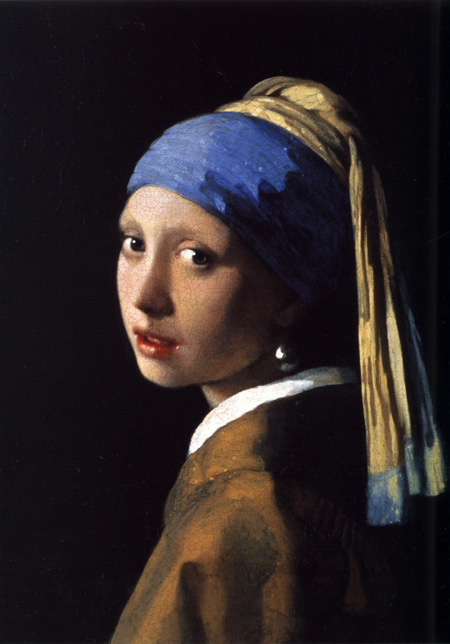
Last month I saw Jan Vermeer’s "Girl with a Pearl Earring" (1665) for the first time and was struck by how radically my experience of the painting differed from preconceptions I’d formed from studying it in reproduction. This iconic work, along with other Dutch paintings from the Mauritshuis in the Hague, is on loan to the de Young Museum in San Francisco (through June 2; http://girl.famsf.org/). Long dubbed “the Mona Lisa of the North,” its subject confronts the viewer with an enigmatic expression that has inspired perennial speculation, a bestselling novel by Tracy Chevalier, and a film adaptation with Scarlett Johansson cast as the eponymously accessorized girl. That girl may or may not have been an actual person; many scholars believe the painting is a tronie – a genericized or archetypal depiction — rather than a portrait.
Regardless, the subject’s enduring allure speaks to the power of the painted face to engage our physiognomic hunger for images that convey both beauty of semblance and nobility of character. She — along with the subjects of works such as Titian’s "Man with a Glove" (c. 1520), Anthony van Dyck’s equestrian portraits of Charles I, Thomas Gainsborough’s "The Blue Boy" (c.1770), and John Singer Sargent’s "Lady Agnew of Lochnaw" (1893) — wear a kind of quintessentially open expression. Not vacant, not dazed, just open. It is the kind of expression that Richard Avedon so craftily elicited from his most famous subjects: unguarded, expectant, and above all serene; the kind of expression that projects back onto you as you project yourself into it.
I was surprised when, at the de Young, Vermeer’s painting seemed to telegraph formal and thematic nuances polar to those I had expected. First of all, photographic plates and digital images had not prepared me for the sensual, painterly crudity with which Vermeer rendered the left shoulder of the girl’s smock. As an isolated passage, it does not look anything like shadowed fabric, but rather like a swath of abstract push/pull straight out of Hans Hoffman. The material’s spatial ambiguity creates a plane of fuzzy focus that sends the viewer’s eye sluicing up to the girl’s face, which is finely brushed. This focal contrast contributes inestimably to the painting’s overall effectiveness, yet it is largely lost to anyone who has not viewed the piece in the flesh. So, too, can reproductions not replicate, nor even approximate, the glistening of museum lighting upon the piece’s dark background, the diamantine fireworks reflecting off myriad cracks beneath the varnish. In reproduction, the background simply looks flat.
Finally and most dramatically, there are the whites of the girl’s eyes. The liquidic pooling of paint within them makes them look welled with tears, a phenomenon that does not fully register in books or online, but casts the figure’s entire expression in a different light. This is not an open gaze, but one that seems wounded, shocked, slapped, as if she has just learned of a parent’s unexpected death or a lover’s betrayal. We do not know, of course, what emotional state Vermeer intended to convey in the handling of those eyes, and any speculation on my part or anyone else’s enters into the hothouse of Tracy Chevalier-style purple prose. We each have our own psychological relationship to canonical masterworks: where we were, and with whom, when we first encountered "The Last Supper," "Guernica," or "Woman I," what they meant to us at the time, what they have come to mean since. In this increasingly digitized age, however, it is not only heartening but necessary to commune with the “real deal,” to discover why a work entered the pantheon in the first place, and to experience or re-experience it — directly — with fresh eyes.
